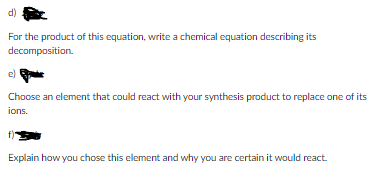d) For the product of this equation, write a chemical equation describing its decomposition. ell Choose an element that could react with your synthesis product to replace one of its ions. Explain how you chose this element and why you are certain it would react.
States of Matter
The substance that constitutes everything in the universe is known as matter. Matter comprises atoms which in turn are composed of electrons, protons, and neutrons. Different atoms combine together to give rise to molecules that act as a foundation for all kinds of substances. There are five states of matter based on their energies of attraction, namely solid, liquid, gases, plasma, and BEC (Bose-Einstein condensates).
Chemical Reactions and Equations
When a chemical species is transformed into another chemical species it is said to have undergone a chemical reaction. It consists of breaking existing bonds and forming new bonds by changing the position of electrons. These reactions are best explained using a chemical equation.
Part C hint: come up with an example of a synthesis equation for an ionic compound.
Part D hint: write a chemical equation describing its decomposition. There’s a connection between synthesis and decomposition. Take a look at part c if that helps.
E hint: choose another element that could react with your synthesis product. Look at part c to answer this question as well. For example, iron could react with magnesium oxide to do the replacement.


Decomposition reaction- It is a type of reaction in which a compound breaks down into two or more simpler products.
It is given by
Replacement reaction- It is the type of reaction in which a more reactive element replaces a less reactive element from its compound to form a new product.
It is given by
Step by step
Solved in 4 steps









